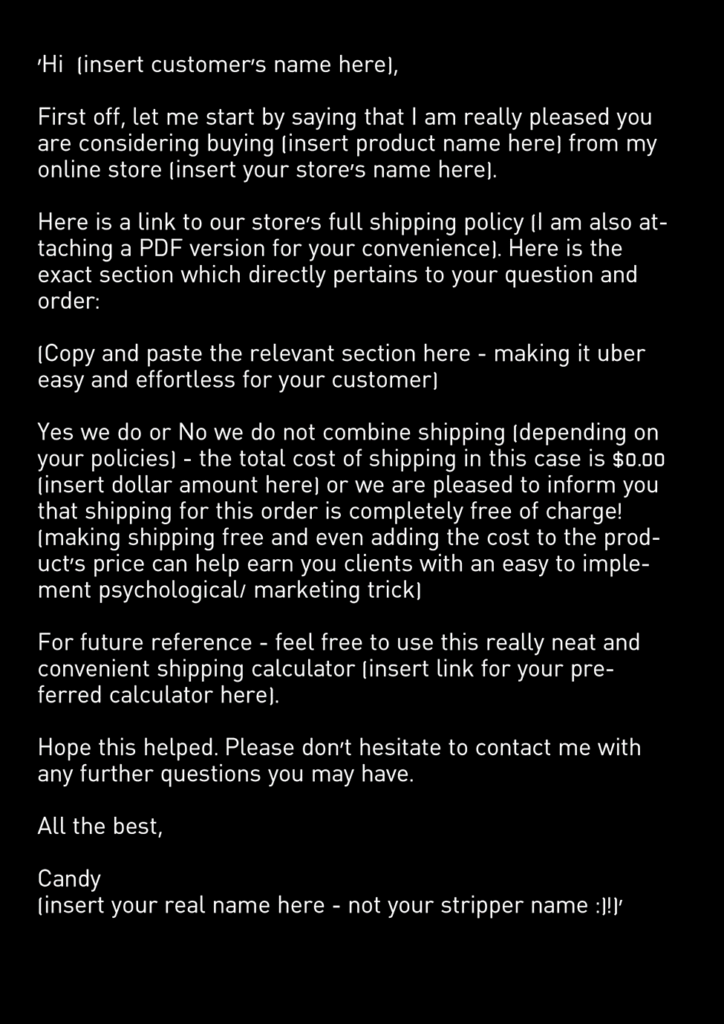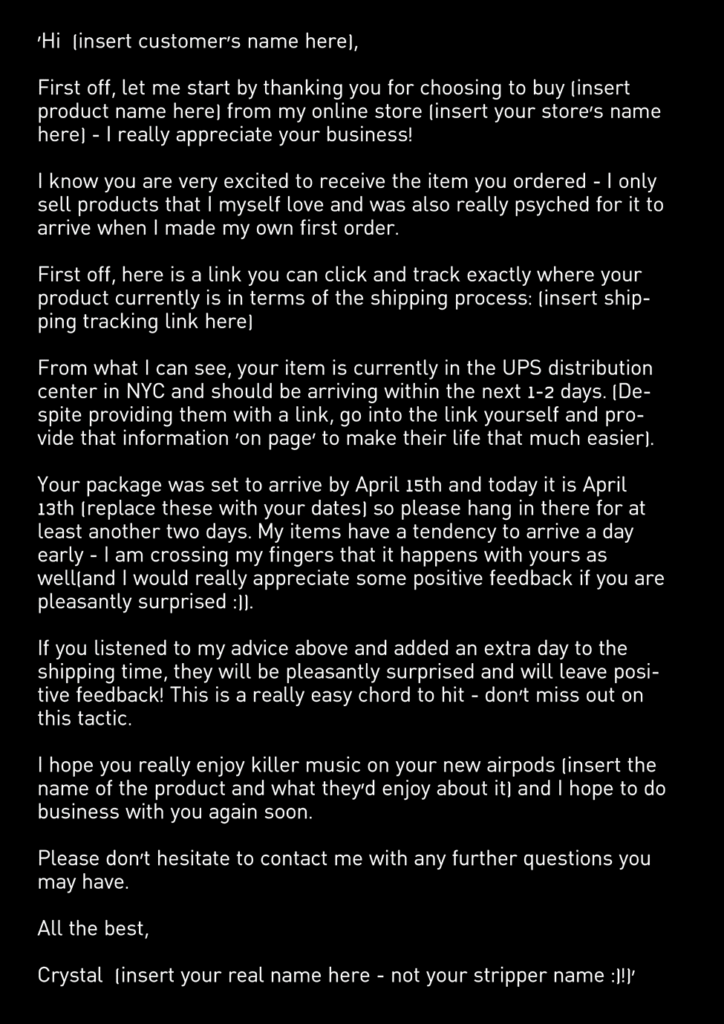3 customer support hacks which will take your eCommerce business to the next level!

In the following post I will analyze the questions below and provide actionable insights on how to not only deal with them, but also on how to leverage them in order to increase your eCommerce business’s profitability. I will provide eCommerce customer service hacks for 3 questions, including:
- ‘Can shipping be combined?’
● Best practice # 1: Convert shoppers by clearly stating your shipping policies
● Advanced Hack: Shipping calculator
● Combined shipping template - ‘’Where is my item? It has not yet arrived!’
● Best practice # 2: Manage expectations
● Package whereabouts template
● Advanced hack: CRM - ‘Is this product in stock?’
● Best Practice #3: Manage your inventory properly
● Advanced hack: Inventory synchronization tool
● In stock / out of stock template
Insights on how better customer support practices can be the key to your eCommerce business’s success

What are the most asked questions ecommerce customer support gets?
In an email I received from Quora on one cold and rainy morning, this exact question popped up. As I was leisurely sipping my Salted Caramel Mocha, I remembered Ian, a buddy of mine who I met while living in NYC.
Ian comes from a typical ‘Scotch- Irish’ family which emigrated to the US in the 1700s. He is tall, has strawberry blond hair, bright emerald eyes and, most importantly, a kind smile and a gentle laugh.

One morning, much like today, rainy and sad, I made time to meet Ian at the Starbucks on Astor Pl. just off Broadway – he seemed uncharacteristically miserable. Waiting for our Pumpkin Spice lattes:
I asked: ‘What on earth is going on with you today? You look like you saw a ghost!’
Ian: ‘I’m just overwhelmed with the sheer volume and scope of customer support questions I am receiving through my eCommerce business. I wish someone would collect some of the most frequently asked eCommerce customer support questions and give me some guidance’.
Back then, there was nothing I could really do to help my pal Ian out as I was not yet involved in the world of eCommerce customer support. However:
- the weather,
- the email from quora
- and the cup of Starbucks coffee
helped create the perfect trifecta triggering my desire to write this post and help all the Ians of the world out there.
In this post, I will analyze the three most common customer support questions which I receive on a regular basis. The value these questions provide could not have been said better by none other than Bill Gates himself:
“Your most unhappy customers are your greatest source of learning.”
These words are true, not only because Bill Gates was the one who said them, but also because they are backed up by extensive research, as well as my own personal business experience. According to research carried out by RightNow, 82% of customers who stop doing business with a company do so because of a poor customer service experience.
82%.
Let that figure sit for a second.
On the other hand of the equation – a happy customer will share his positive experience with 9 people on average. In a recent study carried out by Subivi eCommerce CRM, the 3 most popular customer service questions have been identified by interviewing over 100 active high-volume eBay sellers.
eCommerce Customer Service Question # 1:
Can shipping be combined?
When a customer is looking to buy upwards of one or two products – they will be interested in knowing how the size of their order affects the cost of shipping.

eCommerce customer service best practice # 1:
Convert shoppers by being straightforward about your shipping policies
In this scenario your best bet is to produce a shipping policy template which details your business’s combined shipping policies, including the majority of possible shipping combos and making it abundantly clear which products be ‘group shipped’ and which cannot.
(Template source: TermsFeed)
The advantages of having a shipping policy which shoppers can easily understand and find:
- Makes your brand seem more reliable ito a potential shopper.
- It will reduce the amount of time you spend on repetitive questions.
- Can potentially increase sales, since confusion regarding shipping is a leading cause for shoppers to abandon their cart when making an eCommerce purchase! According to a study presented by ‘tychesoftwares’, nearly 22% of consumers abandon their carts due to unclear shipping costs:

eCommerce Customer Support – Advanced Hack
Providing a link to a shipping cost calculator can do wonders for your shoppers. Providing customers tools such as a calculator allows people to act independently and calculate combined and individual costs on the spot and without having to contact you.
Here are some benefits of providing a cost calculator:
- Simplifying the purchase process makes it less stressful and frustrating for potential buyers. People want everything on the spot including this type of information – by making it accessible to them you are increasing your chances of making more sales.
- This is a fantastic way to collect shopper details in order to market and cross-sell to them in future campaigns. Consider using: www.freightos.com.
Verbatim Customer Support Response
Now that I have given you tips on how to ‘deal’ with this customer support question,here is a ‘template’ which you can use whenever you receive similar customer queries:
I prepared all the templates for you to use in a Word document – click here to download your free copy!

eCommerce Customer Service Question # 2:
‘Where is my item? It has not yet arrived!’
This is a very frustrating question on the sellers part, I know!
Breley 24 hours have passed, of course you have not received it – but what can you do, shoppers today are impatient and if you want to retain business you need to know how to handle these scenarios. Put yourself in their shoes, I am sure that if you were ordering something which you felt was crucial to your daily routine or which you just really want, you woulf feel the same way. Empathizing with and understanding your customer’s perspective is integral to your success as a business.
eCommerce customer service best practice # 2:
Expectation Management
There is a story about an airline which had dissatisfied customers because they had to wait a long time for their baggage. In order to solve this issue, the airline decided to change one thing, switch to a terminal far from the baggage collection area. By doing that, once people got off the plane, they had to walk quite a distance to the baggage claim.

Surprising as it may seem, while the actual user experience became worse, the customer satisfaction rates skyrocketed!
Believe it or not, living up to your consumer’s expectations can exceed many other ‘more crucial’ factors in your business or service!
Here is what you should do,find out how long your carrier estimates shipping will take, then add a day to that projected delivery time and voila you have the perfect recipe for a satisfied customer! How so?, you ask. Good question. The reason is, and for arguments sake let’s say you are located in Washington state and your customer is in Texas. The estimated delivery time is 2 days but you write 3 days. If it in fact does take 3 days to any number of holdups which can and do happen then your customer won’t be disappointed but satisfied. On the other hand, if nothing goes wrong and the carrier, say UPS, does live up to their delivery time, your customer will be ecstatic that they got their item early at no extra cost. That is how you create a long-term relationship with customers – by pleasantly surprising them!
Additionally, make sure you:
- Ensure customers are aware of the projected shipping time.
- Always keep your customers informed – from the second you package to when you ship the item as well as following up when you are informed by your carrier that the item has arrived.
If you ever do receive a message from a shopper, asking you where their item is, don’t freak out. Do keep in mind though that this is definitely a red light which you can and should learn from. The fact that they need to reach out to you means that you made a mistake somewhere along the way and you did not do enough on your end in terms of keeping them in the loop. But don’t sweat it, an earnest apology can go a long way and there is always next time – as long as you internalize your shortfallings!

Verbatim Customer Support Response
Now that I have given you tips on how to ‘deal’ with this customer support question, I will provide you with a ‘template’ which I encourage you to feel free to use when a similar scenario arises with a future customer:

eCommerce Customer Support – Advanced Hack
One tool which can be super effective is a CRM or a Customer Relationship Management tool – it takes the sum of all your past and present dealings with a client and lays it out for you all in one convenient space. We did some research based on an eCommerce seller who decided to employ CRM in his business. The results were astounding: he was able to decrease the amount of time spent on an eBay ticket by more than 50%! Saving him precious time to grow his business which was once used handling customer support issues.

If you choose to use an eBay CRM solution, you’ll be able to create templated answers, so that, once you receive a customer service ticket about a package’s whereabouts for example, you’ll be able to choose the right template and reply effortlessly.
Also, CRM software uses smart tags, which act as place holders for info that is automatically substituted when responding to buyers’ queries. Here is an example:
- The customer’s name, e.g. John Smith
- The package’s tracking number, 9999 9999 9999
- Order status URL, e.g. https://www.fedex.com/apps/fedextrack/?action=track&cntry_code=ca_english.
Here is a short demo of how this works with Subivi, a leading eCommerce CRM solution which provides automatic templates like the ones I mentioned above:

eCommerce Customer Service Question # 3:
‘Is this product in stock?’
‘Why do I always get questions about out of stock items? Is this the universe’s way of getting back at me for forgetting to recycle that one time ;)?
Me

The answer is no, this is not a bad joke. On the contrary, either:
- You have repeat customers who genuinely like what you are selling, so much so that they want to buy it again, or –
- You have first time buyers who really want to make a purchase but are hesitant of the unknown, or –
- You are dealing with a buyer who is looking to make a large purchase.
eCommerce customer service best practice # 3:
Managing your inventory levels
This is an integral part of your business – always ensure that the amount of items displayed on your marketplace (or marketplaces) of choice is correct and up to date.

When you properly manage inventory this is a road which leads to profitability. Here’s why:
- When your inventory is balanced you are never pressured to make unwise restocking purchases at over market prices. But when you are desperate to fill orders you do not have the upper hand and may be forced to pay prices which seriously harm your bottom line.
- When what you are displaying in terms of products is what you actually have in stock you are reaching the full potential of sales as your exposure is in tandem with your levels of stock.
- Having items in stock allows you to supply demand quickly which in turn leads to happy customers who are more likely to buy from you again in the future.
The first step I recommend you take has to do with the communication with your customer. Make sure to clearly state on your product page that you closely watch your inventory levels and that if, for example, they see that there are 2 of these items left on eBay, there is no need to contact you as this is accurate in most instances (apart from an apocalyptic occurrence). This will ensure smother sales and give you more peace of mind.
Here are the two options you have in terms of inventory level tracking:
- The old fashioned way – Keep stock on a Google spreadsheet/ Excel (check out tradegecko’s post on how to manage inventory in Excel for more info on this) or use pen and paper the way 43% of retailers do. Personally, I don’t love this option and believe it is inefficiency at its finest as well as wasting time and money – especially if you have even a decent amount of product turnover.
Consider the following statistics:
$1.1 trillion in yearly revenue is lost due to over or out-of-stock issues
$222.7 billion is lost a year due to a lack of sharing inventory data.
(Source: CrazyLister) When you understand the sheer inefficiency of un-automated inventory management, there is no going back

B. And that leads us to the other option you have, especially good for larger eCommerce sellers who sell on multiple channels like eBay, Amazon and Shopify. It is imperative that you synchronize stock using an automated cloud-based inventory management service. If, for instance, you have 80 bracelets in stock and you sell five of them on Amazon today, the quantity will be updated to 75 across all your selling channels and prevent shortfalls.Available solutions include StichLabs, Tradegecko and Zoho, among others.
eCommerce Customer Support – Advanced Hack
Here are some ideas on better practices when managing inventory with a cloud based inventory synchronization tool:
- Keep exactly the right amount on hand – Too much stock means your cash is a sitting duck with no interest and you are probably paying for storage. Too litte astock and you run the risk of not being able to keep up with demand. Consider using automate sync reminder to restock and learn which products are most popular during which holidays for example.
- Optimize your chain of supply – Keep your friends close and your products even closer. If you don’t already know, understand where customers for specific products are located. Say your bags sell off the shelf in Spain and your watches sell fantastically in Italy. Once you hone in on this, consider renting out storage space to keep the items near potential customer or opt for a local dropshipper which can:
- Decrease shipping times.
- Decrease shipping costs for both yourself and the customer.
- Take shipping taxes out of the equation.
- Potentially save money on storage (especially in a dropshipping scenario).
Verbatim Customer Support Response
Now that I have given you tips on how to ‘deal’ with this customer support question, I will provide you with a ‘template’ for the third time. For this one too, feel free to use this for similar customer queries which may arise in the future:


Final thought
Good customer support is and should be at the core of any eCommerce businesses which aspire to succeed – there is a direct correlation between good customer support and your profit margins! It is extremely important to take buyer feedback and inquiries seriously and to ultimately use this as a tool to streamline your business.
As I mentioned throughout this post, these are the key tools you should consider using:
- A shipping policy template and/or shipping cost calculator
- Consider using a CRM tool (Subivi for example) in order to manage customer complaints and concerns, but also consider using CRMs as a tool of communication, and to let customers know the shipping status of their item.
- Think about using excel sheets to manage inventory (for smaller sellers) and automated cloud-based inventory management services (for larger sellers).
It may seem overwhelming in terms of the quantity of tools an eCommerce seller may need in order to be successful, but growth very often means large quantities of traffic and customers which simply can’t be handled using old fashioned methods.
Circling back to the trigger for this post, I hope my advice helps keep a smile on your face, especially when drinking starbucks while mulling over eCom customer support issues 🙂
If you found this post helpful at all and especially if you vehemently disagree – let me know why? What did I miss? How would you improve this post ?
Alternatively, you could pay me a small compliment 🙂
Either way – please post YOUR most common eCommerce customer support question below and include any tips or hacks for other sellers.
I will do my best to answer all of your comments and questions and would be happy to provide hacks and tips for those hard to tackle enigmatic questions which have been gnawing away at you.
Thanks for reading 🙂
